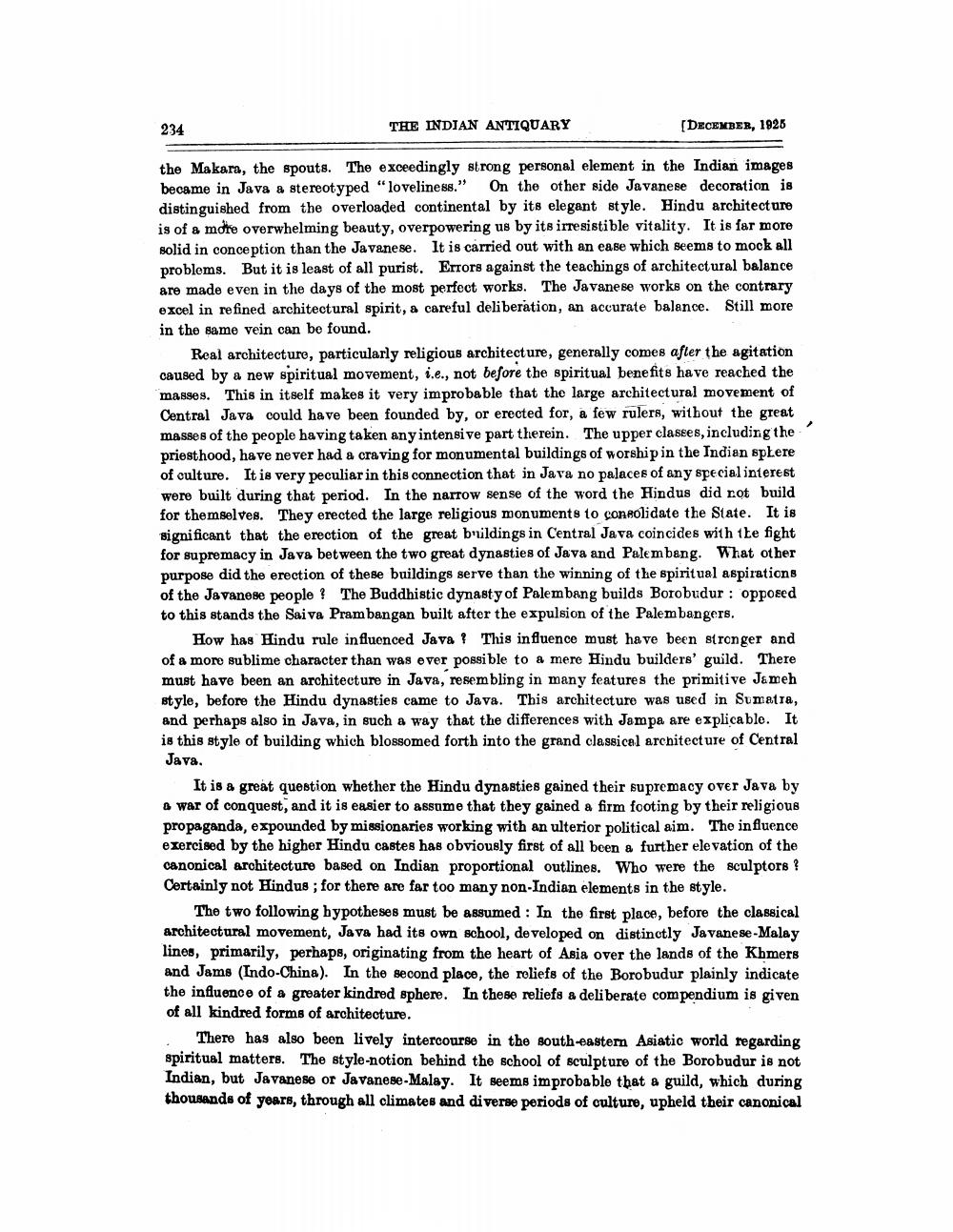________________
234
THE INDIAN ANTIQUARY
[DECEMBER, 1925
the Makara, the spouts. The exceedingly strong personal element in the Indian images became in Java a stereotyped "loveliness." On the other side Javanese decoration is distinguished from the overloaded continental by its elegant style. Hindu architecture is of a more overwhelming beauty, overpowering us by its irresistible vitality. It is far more solid in conception than the Javanese. It is carried out with an ease which seems to mock all problems. But it is least of all purist. Errors against the teachings of architectural balance are made even in the days of the most perfect works. The Javanese works on the contrary excel in refined architectural spirit, a careful deliberation, an accurate balance. Still more in the same vein can be found.
Real architecture, particularly religious architecture, generally comes after the agitation caused by a new spiritual movement, i.e., not before the spiritual benefits have reached the masses. This in itself makes it very improbable that the large architectural movement of Central Java could have been founded by, or erected for, a few rulers, without the great masses of the people having taken any intensive part therein. The upper classes, including the - priesthood, have never had a craving for monumental buildings of worship in the Indian sphere of culture. It is very peculiar in this connection that in Java no palaces of any special interest were built during that period. In the narrow sense of the word the Hindus did not build for themselves. They erected the large religious monuments to consolidate the State. It is significant that the erection of the great buildings in Central Java coincides with the fight for supremacy in Java between the two great dynasties of Java and Palembang. What other purpose did the erection of these buildings serve than the winning of the spiritual aspirations of the Javanese people? The Buddhistic dynasty of Palembang builds Borobudur: opposed to this stands the Saiva Prambangan built after the expulsion of the Palembangers.
How has Hindu rule influenced Java? This influence must have been stronger and of a more sublime character than was ever possible to a mere Hindu builders' guild. There must have been an architecture in Java, resembling in many features the primitive Jameh style, before the Hindu dynasties came to Java. This architecture was used in Sumatra, and perhaps also in Java, in such a way that the differences with Jampa are explicable. It is this style of building which blossomed forth into the grand classical architecture of Central Java.
It is a great question whether the Hindu dynasties gained their supremacy over Java by & war of conquest, and it is easier to assume that they gained a firm footing by their religious propaganda, expounded by missionaries working with an ulterior political aim. The influence exercised by the higher Hindu castes has obviously first of all been a further elevation of the canonical architecture based on Indian proportional outlines. Who were the sculptors ? Certainly not Hindus; for there are far too many non-Indian elements in the style.
The two following hypotheses must be assumed: In the first place, before the classical architectural movement, Java had its own school, developed on distinctly Javanese-Malay lines, primarily, perhaps, originating from the heart of Asia over the lands of the Khmers and Jams (Indo-China). In the second place, the reliefs of the Borobudur plainly indicate the influence of a greater kindred sphere. In these reliefs a deliberate compendium is given of all kindred forms of architecture.
There has also been lively intercourse in the south-eastern Asiatic world regarding spiritual matters. The style-notion behind the school of sculpture of the Borobudur is not Indian, but Javanese or Javanese-Malay. It seems improbable that a guild, which during thousands of years, through all climates and diverse periods of culture, upheld their canonical




